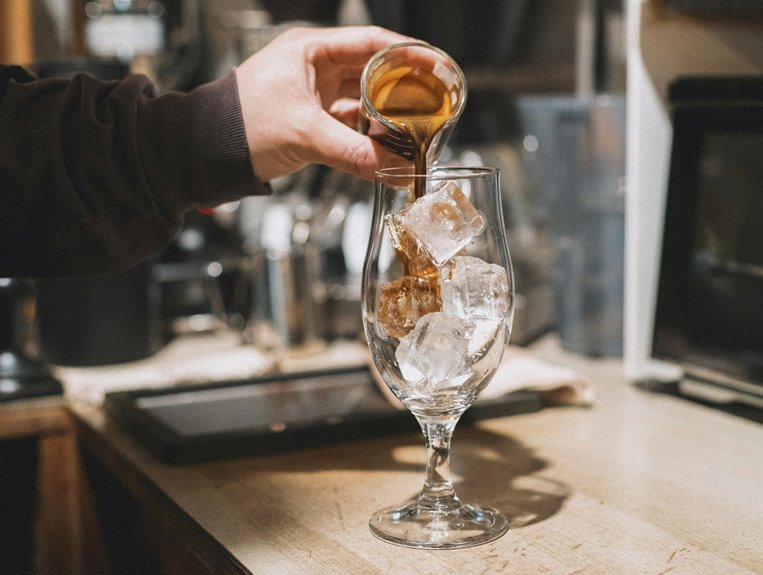Caffeine Content Unveiled: How Much Is in a Pot of Coffee?

When we talk about caffeine content in coffee, it's fascinating to realize how much it can differ from one pot to another. We often assume that all coffee is created equal, but factors like bean type, brewing method, and even serving size play essential roles in determining the total caffeine we consume. For instance, did you know a standard pot could contain over 1,200 mg of caffeine? Understanding these nuances not only helps us manage our intake, but it also raises questions about our daily habits. What else should we consider?
Understanding Caffeine Basics
When we consider the widespread allure of caffeine, its role as a stimulant becomes clear.
Our bodies metabolize caffeine through the liver, affecting how long it stays in our system. Over time, we develop caffeine tolerance, requiring higher doses to achieve the same stimulating effects.
Understanding these dynamics helps us appreciate how caffeine impacts our daily lives and overall well-being.
Factors Influencing Caffeine Levels
Caffeine levels in coffee can vary considerably based on several factors, impacting how we experience its effects.
Roast levels, bean origin, and grind size greatly influence the extraction rate. Additionally, brewing time and water temperature play vital roles in determining caffeine content.
Serving style also matters, as coffee blends can differ in strength, affecting our overall caffeine intake.
Understanding these factors helps us make informed choices.
Types of Coffee Beans
Exploring the different types of coffee beans reveals significant variations in flavor, aroma, and caffeine content.
Arabica beans, known for their smooth taste, originate primarily in Latin America, while robusta beans, with a bolder flavor and higher caffeine content, come from Africa and Southeast Asia.
Understanding arabica vs. robusta helps us appreciate the diversity in our coffee experiences and choices.
Brewing Methods Explained
While various brewing methods can greatly impact our coffee's flavor and caffeine extraction, understanding these techniques is essential for optimizing our coffee experience.
Different brewing techniques, such as pour-over, French press, and espresso, require specific extraction times to maximize caffeine yield.
For instance, longer extraction times typically enhance caffeine content, while shorter ones may produce a milder flavor profile.
Caffeine Content by Serving Size
When we consider caffeine content, it's essential to look at standard brew measurements and how they affect the caffeine per cup.
Different serving sizes can markedly influence the total caffeine intake, revealing a complex relationship between preparation methods and caffeine levels.
Additionally, various factors such as bean type and brewing time further complicate this picture, making it vital for us to understand these dynamics.
Standard Brew Measurements
Caffeine levels in coffee can vary considerably based on serving size and brewing method. Understanding standard brew measurements helps us grasp the relationship between brew strength and caffeine content. Here's a simple breakdown:
| Serving Size | Brew Strength | Caffeine Content |
|---|---|---|
| 8 oz | Medium | 95 mg |
| 12 oz | Strong | 150 mg |
| 16 oz | Extra Strong | 200 mg |
Caffeine Per Cup
Understanding how caffeine content varies by serving size is essential for making informed choices about our coffee consumption.
Typically, an 8-ounce cup contains about 95 milligrams of caffeine, but this can differ based on preparation methods and cup measurements.
We should be wary of caffeine myths suggesting more isn't always better, as serving sizes directly impact our overall intake and experience.
Factors Affecting Levels
Numerous factors influence the caffeine content in our coffee, particularly regarding serving size. Understanding these variables helps us make informed choices:
- Bean origin: Different regions produce beans with varying caffeine levels.
- Roast level: Darker roasts often contain slightly less caffeine than lighter roasts due to the roasting process.
- Brewing method: Techniques like espresso yield higher caffeine concentration per ounce compared to drip coffee.
Comparing Drip vs. Espresso
When we plunge into the world of coffee, one of the most intriguing comparisons is between drip coffee and espresso.
Drip advantages include a gentler caffeine release, making it ideal for longer sipping.
In contrast, espresso intensity packs a punch, delivering a concentrated caffeine boost in a small volume.
Understanding these differences helps us choose the right brew for our needs.
Decaf Coffee: The Myths
While we've explored the vibrant differences between drip coffee and espresso, it's time to address a common misconception surrounding decaf coffee.
Many think decaf means zero caffeine, but that's not entirely true.
Let's clarify a few decaf misconceptions:
- Decaf still contains some caffeine.
- Caffeine extraction varies by method.
- It's not caffeine-free, just considerably lower.
Understanding these points helps demystify decaf coffee for all of us.
Daily Caffeine Recommendations
Caffeine serves as a daily fuel for many of us, but understanding how much we should consume is essential for our health.
The generally accepted daily limit is 400 milligrams, roughly equivalent to four 8-ounce cups of brewed coffee.
Exceeding this can lead to caffeine withdrawal symptoms, highlighting the importance of adhering to these daily limits for ideal well-being.
Health Effects of Caffeine
Understanding the health effects of caffeine is essential for anyone who relies on it for daily energy.
While caffeine can enhance cognitive performance and offer health benefits, we should be aware of its potential drawbacks:
- Caffeine sensitivity varies among individuals.
- Withdrawal symptoms can occur with reduced intake.
- Sleep interference and cardiovascular effects are concerns for some.
Conclusion
To sum up, understanding the caffeine content in a pot of coffee is essential for managing our consumption effectively. By considering factors like bean type, brewing method, and serving size, we can make informed choices that align with our health goals. Whether we prefer a strong drip or a smooth espresso, being aware of caffeine levels helps us enjoy our coffee while remaining within daily recommendations. Ultimately, it's all about balance and mindfulness in our coffee-drinking habits.






